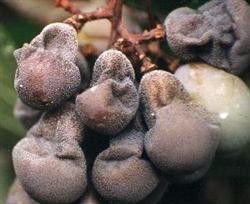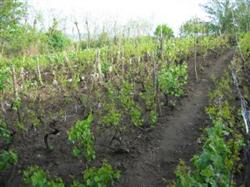Grape should be protected from white rot in rainy days during ripening period.

White rot is one of the main diseases of grape, especially in the old vineyard, when the grape is about to mature, the disease is serious in continuous overcast and rainy weather, which often causes great losses. The disease of grape white rot usually begins in the middle and late July, which mainly harms the ear and the new fruit, and the fruit is more susceptible to the disease during the ripening period. The disease of the ear often occurs in the ear near the ground. after the disease is infected, the light brown rot spot appears on the ear axis or pedicel, and the disease part gradually loses water and shrinks and spreads to the fruit grain, which makes the whole ear rot and the vibration diseased ear grain fall off. At the beginning of the disease, the disease spot was water-immersed light brown oval, with the expansion of the disease spot, the epidermis turned brown, the disease part often split into hemp, the middle constricted, and sometimes the junction of the disease and health became thicker or tumor-like due to the obstruction of nutrient transport. Leaf disease occurs mostly at the tip of the leaf, forming brown concentric wheel striated spots, which are easy to be broken. In order to control grape white rot, cultivation management should be strengthened. Thoroughly clean the orchard to reduce the source of disease; increase the application of organic fertilizer to enhance the disease resistance of the plant; improve the fruiting position, pick the heart and shoot in time, so as to facilitate ventilation and light in the field; bagging the ear after flowering to avoid the invasion of germs; cut off the diseased fruit and branches in time, and concentrate on burying deeply. Chemical control began in mid-late July, with 50% thiophanate methyl wettable powder or 50% carbendazim wettable powder 800 times spray, once every 10 to 15 days, continuous control 3 times, has a good prevention and control effect on white rot.
- Prev

Three times of medicine for grape disease control
1. Skin. In early spring, first spread a layer of plastic film under the grape tree, and then peel off the skin on the branches, so that it falls on the film, at the same time cut off the diseased branches, together with the skin on the film together in the garden burning treatment. Second, deep ploughing. Combined with the application of grape bud fertilizer, a deep ploughing of the whole garden, the depth of 2...
- Next

How to strengthen the management of the flowering period of grape planted in greenhouse
1. Pick your heart at the right time. The grapes planted in the shed should be reshaped by hedgerows, and the hearts should be picked early to control the growth. When the main vine grows to 60ml 80cm, the top accessory shoots are removed to leave winter buds, and the other secondary shoots are left with one leaf to pick the heart. 25 days later, when the apical winter buds germinated and grew 6 Mel 7 leaves, 5 leaves were left to pick the heart, and the apical accessory shoots were removed and the winter buds were left again.
Related
- Moge, come on! The staff of the peasant association in the producing area of cantaloupe were frightened when the crowd gathered.
- Causes and Solutions of low Fruit setting rate of Apple
- Symptoms and control measures of passion fruit virus disease
- Fruit growing lesson: how do apple orchards keep high yields?
- Can you build orchards in the mountains? What are the pros and cons?
- How to manage the coloring period of Crisson grape?
- This paper introduces the processing technology of two kinds of fig products.
- How much is a month for retired teachers in rural areas by 2020?
- How can strawberry planting increase sugar content? We should pay attention to management in many aspects.
- What are the cultivation techniques on how to improve the yield of golden fruit?

